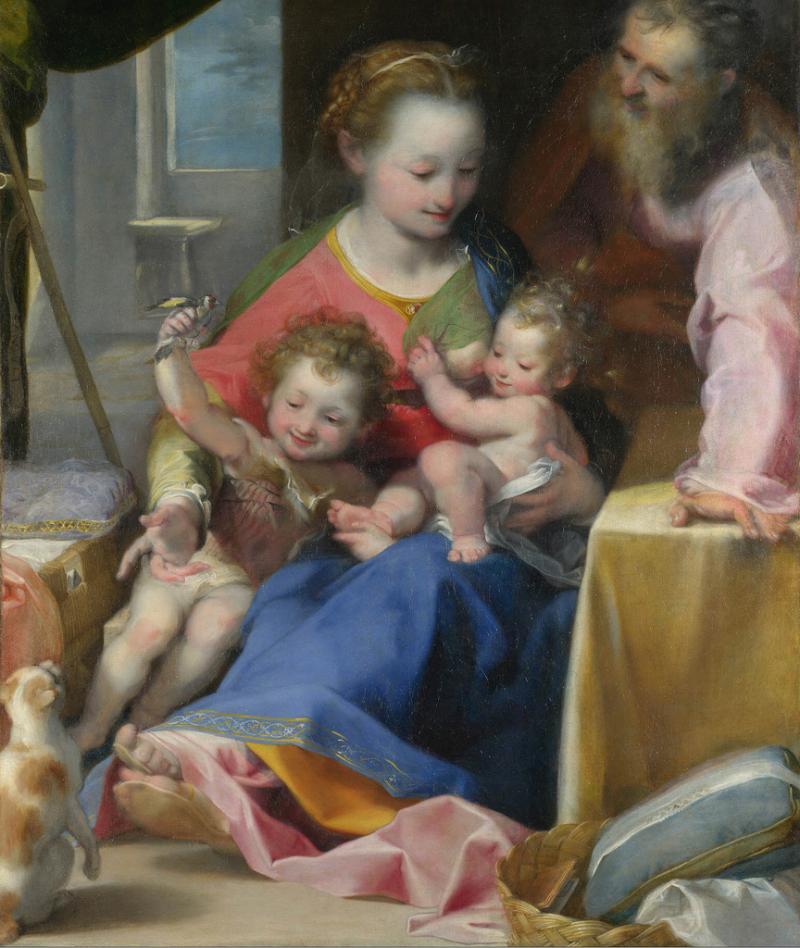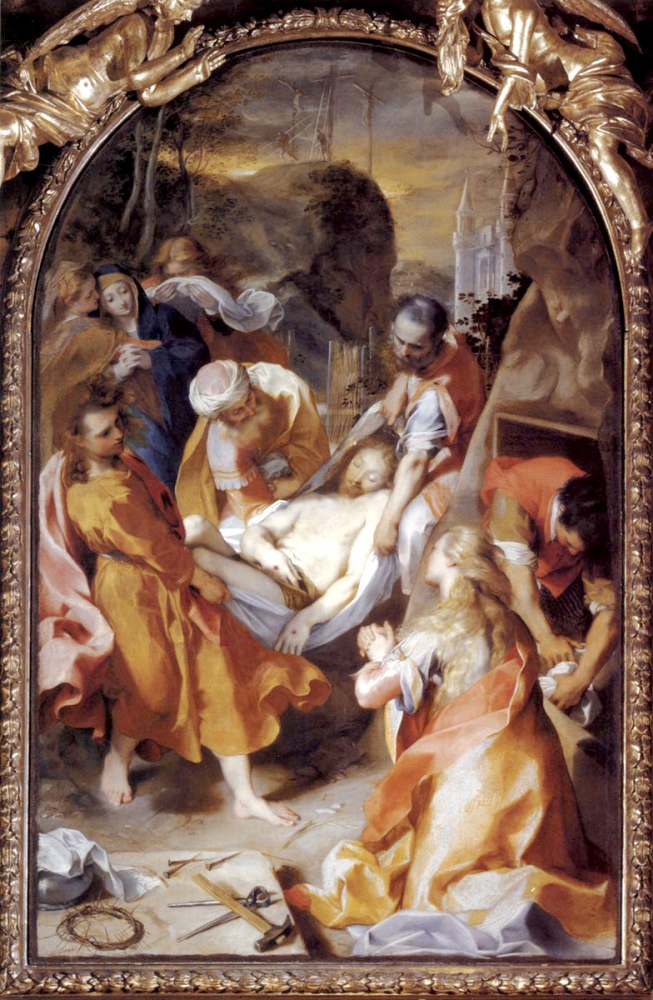Federico Barocci: Brilliance and Grace, National Gallery | reviews, news & interviews
Federico Barocci: Brilliance and Grace, National Gallery
Federico Barocci: Brilliance and Grace, National Gallery
Renaissance artist from Urbino arrives on the world stage

Federico Barocci, who he? According to the National Gallery, a great Renaissance, mannerist and Baroque painter hardly known outside Italy, the National’s own Madonna of the Cat his only easel painting in a public collection in the UK.
This monographic exhibition devoted to the Urbino-based artist is an atmospheric display with most of the large paintings being shown outside their Italian host churches for the first time. The elaborate and crowded narratives focus on a handful of the major episodes of Christianity, from the Annunciation to the Deposition, and are accompanied by superbly fluent preparatory drawings and oil sketches and an incisive series of real-life portraits (The Entombment of Christ, below).
 Barocci's story is distinctly odd: he was an early success, gaining the attention of Michelangelo, but was reportedly poisoned by jealous peer-group painters when making his way in Rome, the city of choice for any ambitious artist of the period. He retreated back home to Urbino, with its healthier air and relative remoteness from the competitive atmosphere of Rome, although he still enjoyed papal patronage, and spent most of his devout life dedicated to making massive religious paintings with a surprisingly light and airy touch. He was commissioned by the Duke of Urbino among others: the ducal palace is glimpsed as background in several compositions.
Barocci's story is distinctly odd: he was an early success, gaining the attention of Michelangelo, but was reportedly poisoned by jealous peer-group painters when making his way in Rome, the city of choice for any ambitious artist of the period. He retreated back home to Urbino, with its healthier air and relative remoteness from the competitive atmosphere of Rome, although he still enjoyed papal patronage, and spent most of his devout life dedicated to making massive religious paintings with a surprisingly light and airy touch. He was commissioned by the Duke of Urbino among others: the ducal palace is glimpsed as background in several compositions.
His own self portrait, painted as he headed into his seventies, shows a prosperous but melancholic and even haunted face. His ill health dogged him and contributed to his working practices, which involved meticulous preparation in his magnificent drawings and a relatively small output of large scale paintings which required much more physical effort.
Yet these paintings are almost blindingly euphoric and optimistic; everyone is beautifully rounded, well muscled and well nourished. Even the crucified Christ is seemingly unperturbed by His suffering, while the Virgin is rosy-cheeked and rosy-lipped and even rosy-nippled. The Last Supper (below) is a crowd scene, for as well as the diners there's a host of athletic servants scrubbing pewter plates, while glasses and carafes containing water are brilliantly convincing. In The Visitation, the observant maidservant carries a basket of hens as she observes the pretty and pregnant Virgin Mary meeting her cousin St Elizabeth, pregnant with the future St John the Baptist, while St Joseph is accompanied by a donkey looking over his shoulder. A donkey also features in the Rest on the Return from Egypt, where Mary is the central figure, dipping her cup into a pond for refreshment. Barocci is enchanted by Mary throughout, and returns to her several times: she is eternally young, her skin glowing, eyes downcast, a dignified amalgam of innocence and modesty, but with a frisson of seductive charm.
 The actors in these elaborate set pieces are based on both observing ordinary people and hiring them as models, yet by the time they appear as saints they are idealised, almost irritatingly so, and framed by angels. But there can be a subtle wit: the complex Madonna of the Cat shows us an alert young tortoiseshell cat gazing hungrily up at the finch clutched in the baby St John the Baptist’s hand. We can almost hear the anticipatory purr. The luxuriously costumed Holy Family is nicely situated in a Renaissance palace; Mary’s delicately rounded pink nippled right breast is on offer to her child. And could his portrait of Francisco Maria II della Rovere, a warrior in his prime, a successful soldier in the Battle of Lepanto, a relative of popes, a ruler of Urbino, be completely straight-faced? His garb is conspicuously consumerist, encased as he is with ceremonial armour, sashed in red and gold with even the plumes on his helmet seriously exuberant.
The actors in these elaborate set pieces are based on both observing ordinary people and hiring them as models, yet by the time they appear as saints they are idealised, almost irritatingly so, and framed by angels. But there can be a subtle wit: the complex Madonna of the Cat shows us an alert young tortoiseshell cat gazing hungrily up at the finch clutched in the baby St John the Baptist’s hand. We can almost hear the anticipatory purr. The luxuriously costumed Holy Family is nicely situated in a Renaissance palace; Mary’s delicately rounded pink nippled right breast is on offer to her child. And could his portrait of Francisco Maria II della Rovere, a warrior in his prime, a successful soldier in the Battle of Lepanto, a relative of popes, a ruler of Urbino, be completely straight-faced? His garb is conspicuously consumerist, encased as he is with ceremonial armour, sashed in red and gold with even the plumes on his helmet seriously exuberant.
Especially memorable is the wonderful range of glowing, incandescent colour in the great set pieces, the acid yellows and greens anticipating Poussin’s memorable Roman palette a century later. Textured draperies and costumes shine in an array of blues, lilacs, whites, reds, pinks: even the martyrs are cheerful, and the light-filled skies are an antidote to London's winter greys.
At the National Gallery until 19 May
Explore topics
Share this article
The future of Arts Journalism
You can stop theartsdesk.com closing!
We urgently need financing to survive. Our fundraising drive has thus far raised £49,000 but we need to reach £100,000 or we will be forced to close. Please contribute here: https://gofund.me/c3f6033d
And if you can forward this information to anyone who might assist, we’d be grateful.

Subscribe to theartsdesk.com
Thank you for continuing to read our work on theartsdesk.com. For unlimited access to every article in its entirety, including our archive of more than 15,000 pieces, we're asking for £5 per month or £40 per year. We feel it's a very good deal, and hope you do too.
To take a subscription now simply click here.
And if you're looking for that extra gift for a friend or family member, why not treat them to a theartsdesk.com gift subscription?
more Visual arts
 'We are bowled over!' Thank you for your messages of love and support
Much-appreciated words of commendation from readers and the cultural community
'We are bowled over!' Thank you for your messages of love and support
Much-appreciated words of commendation from readers and the cultural community
 Folkestone Triennial 2025 - landscape, seascape, art lovers' escape
Locally rooted festival brings home many but not all global concerns
Folkestone Triennial 2025 - landscape, seascape, art lovers' escape
Locally rooted festival brings home many but not all global concerns
 Sir Brian Clarke (1953-2025) - a personal tribute
Remembering an artist with a gift for the transcendent
Sir Brian Clarke (1953-2025) - a personal tribute
Remembering an artist with a gift for the transcendent
 Emily Kam Kngwarray, Tate Modern review - glimpses of another world
Pictures that are an affirmation of belonging
Emily Kam Kngwarray, Tate Modern review - glimpses of another world
Pictures that are an affirmation of belonging
 Kiefer / Van Gogh, Royal Academy review - a pairing of opposites
Small scale intensity meets large scale melodrama
Kiefer / Van Gogh, Royal Academy review - a pairing of opposites
Small scale intensity meets large scale melodrama
 Jenny Saville: The Anatomy of Painting, National Portrait Gallery review - a protégé losing her way
A brilliant painter in search of a worthwhile subject
Jenny Saville: The Anatomy of Painting, National Portrait Gallery review - a protégé losing her way
A brilliant painter in search of a worthwhile subject
 Abstract Erotic, Courtauld Gallery review - sculpture that is sensuous, funny and subversive
Testing the boundaries of good taste, and winning
Abstract Erotic, Courtauld Gallery review - sculpture that is sensuous, funny and subversive
Testing the boundaries of good taste, and winning
 Edward Burra, Tate Britain review - watercolour made mainstream
Social satire with a nasty bite
Edward Burra, Tate Britain review - watercolour made mainstream
Social satire with a nasty bite
 Ithell Colquhoun, Tate Britain review - revelations of a weird and wonderful world
Emanations from the unconscious
Ithell Colquhoun, Tate Britain review - revelations of a weird and wonderful world
Emanations from the unconscious
 Rachel Jones: Gated Canyons, Dulwich Picture Gallery review - teeth with a real bite
Mouths have never looked so good
Rachel Jones: Gated Canyons, Dulwich Picture Gallery review - teeth with a real bite
Mouths have never looked so good
 Yoshitomo Nara, Hayward Gallery review - sickeningly cute kids
How to make millions out of kitsch
Yoshitomo Nara, Hayward Gallery review - sickeningly cute kids
How to make millions out of kitsch
 Hamad Butt: Apprehensions, Whitechapel Gallery review - cool, calm and potentially lethal
The YBA who didn’t have time to become a household name
Hamad Butt: Apprehensions, Whitechapel Gallery review - cool, calm and potentially lethal
The YBA who didn’t have time to become a household name

Add comment